A day in the life of a Finnish timber mill
Words and images - Nicolas Pratt
A few kilometres west of the Russian border the deafening sound of machinery is only surpassed in power by their hypnotic rhythm. The unloading, transferring, cutting, sorting, trimming, grading, planing, drying, packing, and finally, transportation of wood is an impressive, highly precise practice.
I witnessed this - the early phase in the life of a timber product – along with my fellow Wood Program students at the Stora Enso factory in Southern Finland.
Observing the production of their high quality, knotless, Effex Panels, our tour starts outside in the sub-zero conditions. Piles of 5 metre long wooden logs are stacked higher than the nearby cranes seem to be able to reach. These damp logs are awaiting entry into the factory; a journey reached via long, elevated conveyor belts and concluded by several circular saws.
As we enter the factory we observe how the entirety of each incoming log is utilised. The cuts get smaller, precision becomes finer and detail becomes more important with each progression. The large amount of saw dust that falls on the ground is recycled either as fuel to power the factory or as a material for composite wood products such as MDF. Sawdust and intimidatingly large splinters are ever-present and cling to the machinery due to their greasy nature.
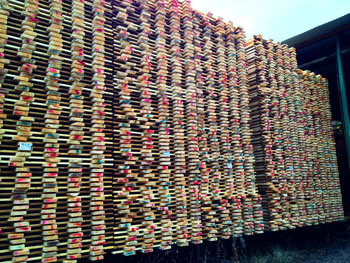
Like match sticks. Freshly cut pieces waiting entry into the kiln.
Touring around the factory we climb up, above, over, down and under the production line. Five metre long planks of moist timber are continually shooting along metal rollers faster than the eye can track. There is always movement. Our need for high-vis vests, hard hats and ear plugs is definitely warranted. The most impressive feature of this visit – from an architectural viewpoint - is the simultaneously symmetrical processing of the logs. Initial slices on both sides fall from the center piece in a mirrored fashion. It is as if the entire factory has a fictional line drawn down the center of it with a huge mirror reflecting the procedure.
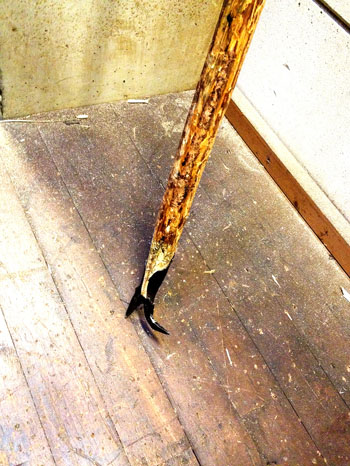
The makeshift prodding device
Ninety-nine percent of the operation is automated. Only occasionally do we see human interaction with the machinery – usually in the form of an employee pushing a single red button repeatedly or reacting when a piece gets jammed in the machinery. Crude tools are used to unclog the production line; a rough bit of timber – possibly an old broom handle – with a small metal hook completing the prodding device.

Every last piece is used. The mountain of saw dust is feedstock for energy production
Despite the fact that this is one of Europe’s largest working timber saw mills, the whole process is, unfortunately, quite dirty looking as a result of the juxtaposition between its antiquated and modern machinery. This Stora Enso site is solidly embedded into the history of Finnish timber production; corridor walls are lined with black and white photos of hundreds of thousands of logs backed up on the nearby lake and up along the accompanying river, awaiting processing. It is an impressive image of the manually driven industry from only 50 years ago - unparalleled by the ordered piles of logs and lines of instruments witnessed today.
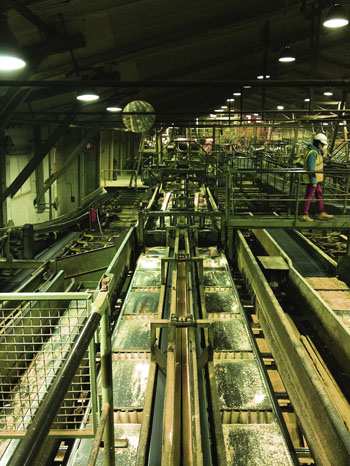
Like a mirror. The factory is mirrored to work on both sides of the logs simultaneously
By far the most remarkable aspect of the production line of wood processing is the speed and accuracy in which the quality of the wood is assessed. After a particular size or profile is cut, planks are transported in single file under a bright light. Each plank is exposed only for a fraction of a second, during which a digital image is taken from above, the contrast (between the dark knots and rest of the wood) is analyzed, and its quality determined. A high number of knots signify a low-grade timber. This process is repeated by a second bright light + camera, once the plank has been flipped (in an equally impressive mechanical maneuver). The planks are then automatically dropped into piles of matching quality, each set being used for varying purposes.
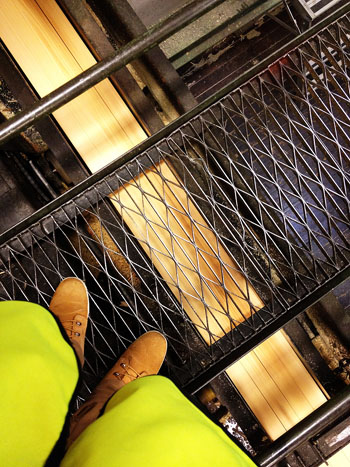
Logs pass under my feet
Towards the end of the seemingly endless rows of identical machines transporting freshly cut pieces down the line, and after each cut has been graded, ordered, labelled and stacked into piles, they are oven dried for around 12 hours. Finally they are packed into protective covers and eventually delivered around the world.
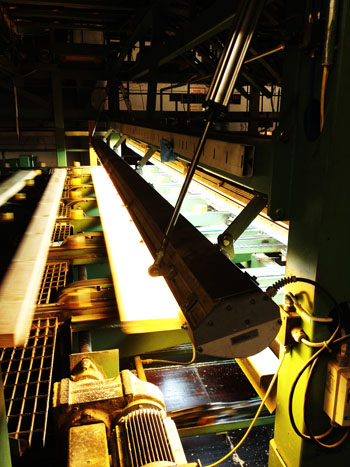
Determining the quality of the wood
We leave the saw mill with a new appreciation of not only the scale of timber production across the globe, but of the radical developments that the industry has seen in such a short time. How will this site look when another group of burgeoning wood experts visit 50 years from now?
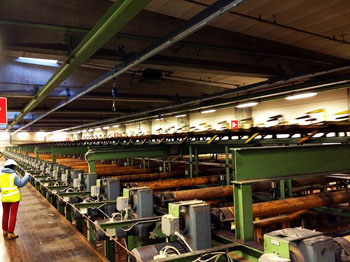
Rows and rows of sorting machines
